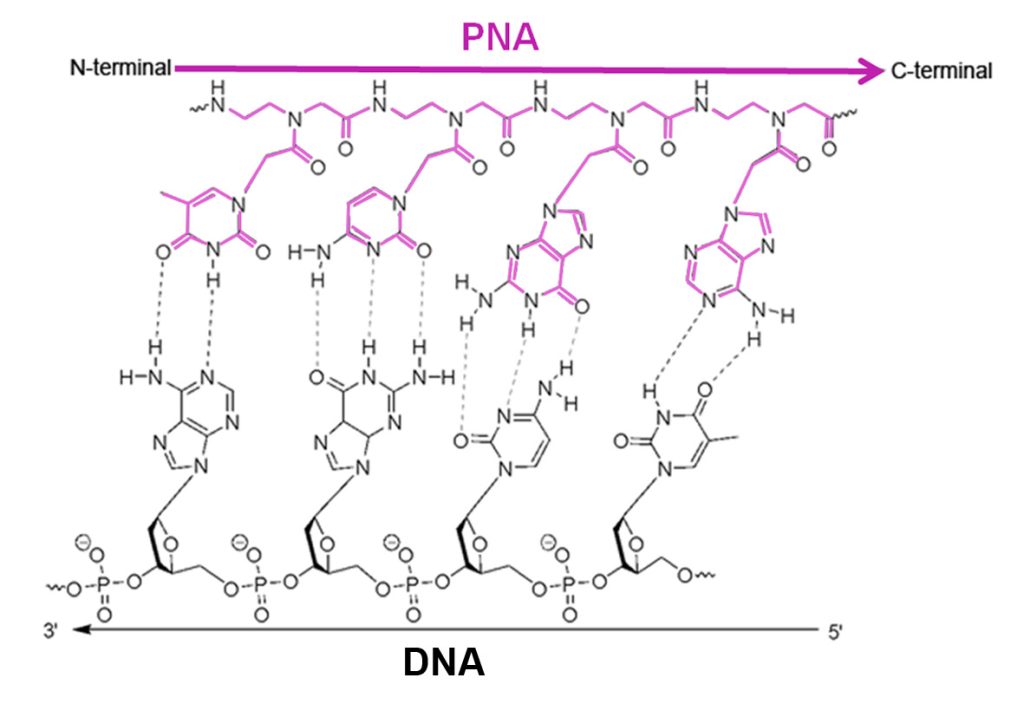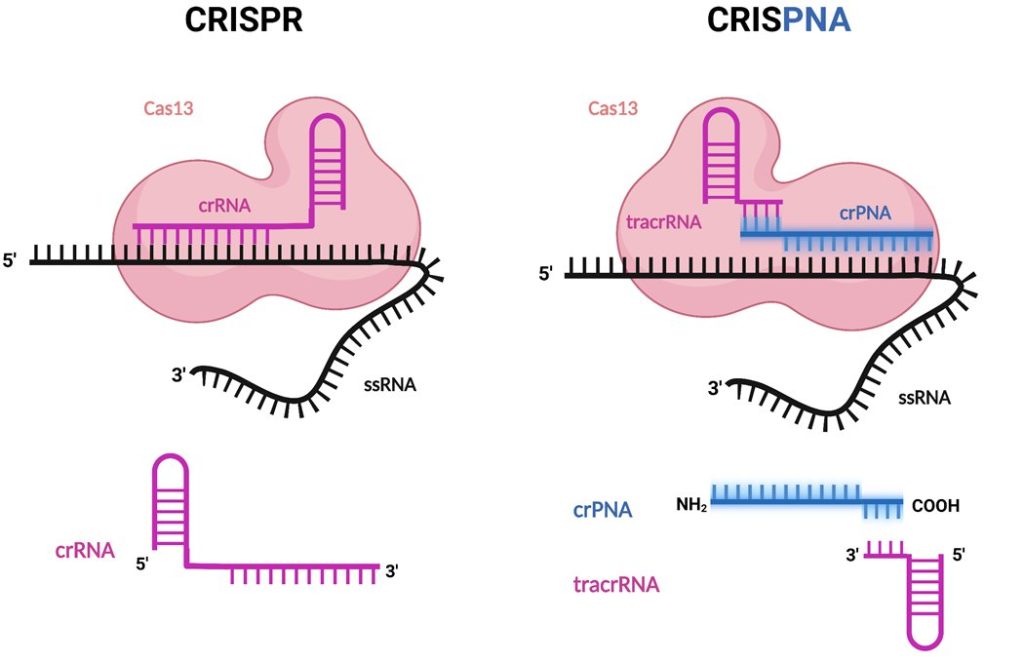OUR SCIENCE
The CRISPNA technology, patented (WO2022144437A1-07/07/2022) and licensed to CRISPNA Bio, arises with the idea of generating a new genomic editing tool based on CRISPR systems, but with better characteristics in terms of specificity and robustness. For this, the versatility and properties of Cas proteins with the best affinity, specificity and stability characteristics of PNAs are used, compared to RNA. In theory, this technology can generate CRISPNA systems based on most of the existing CRISPR systems, specially we will focus on Cas9 and Cas13. This technology has been a technology-based company that was born thanks to this patent.
Although CRISPR/Cas systems are powerful technologies that are changing the way scientists address unsolved problems in basic biology, therapy, and diagnostics. In its present forms, CRISPR/Cas systems require RNA molecules (crRNA or sgRNA) to direct the different Cas proteins towards their DNA or RNA targets. RNA molecules are unstable and can allow for various mismatches when binding to their target, which can result in lack of reproducibility, mutations in unwanted genes, and false positives.
Peptide Nucleic Acids (PNAs) are artificially synthetic oligonucleotides that display higher affinity to complementary DNA and RNA than do normal oligonucleotides. Therefore, PNA-RNA and PNA-DNA bindings are more stable and specific than RNA-DNA. In addition, their uncharged backbone makes PNAs extremely stable in biological fluids, since they are resistant to proteases and nucleases.

CRISPNA is an alternative to CRISPR systems and can be used to improve the efficacy and specificity of all applications in which CRISPR has been used. Therefore, CRISPNA can be used to manipulate DNA and RNA, as well as a tool to detect and/or image specific DNA and RNA sequences. Importantly, it can be used in living cells as well as in different fluids.
The design of the CRISPNA system is based on the replacement of the spacer crRNA sequence that directs the Cas protein to its targets by a more stable and specific PNA molecule. Because different Cas proteins have different compositions, the design will be different for each one. For Cas type II proteins (Cas9), a crPNA replaces the crRNA sequence leaving the tracrRNA sequence intact (Figure A). To adapt the CRISPR type VI (Cas13) system to CRISPNA, (only one crRNA molecule exists in nature that binds to both the Cas13 protein and the RNA target), first the 41-50 bp crRNA is It has been divided into two parts (Figure B): a tracrRNA that will bind to the Cas proteins and that has a linker to bind to the crPNA. For its part, the crPNA will direct the Cas protein to its target, and which in turn will also have a linker to join the designed tracrRNA.
A)

B)

The CRISPNA system has applications in all areas where the CRISPR/Cas system has already demonstrated its potential:
- Gene therapy: CRISPNA could be used to modify the genome of human cells for therapeutic purposes in a more precise way.
- Agriculture: CRISPNA could be applied to create transgenic plants and animals.
- Diagnostic: CRISPNA could be used to develop more accurate and robust diagnostic tests.
- Basic research
- Pest control
- Biotechnology
Actually, we are focus on validating the CRISPNA technology in terms of its ability to be more specific, sensitive and/or robust than CRISPR systems initially using two Cas enzymes (Cas9 and Cas13a) and their application to therapy and diagnosis:
Specifically, the two applications in which we will work are:
- Diagnostic applications. CRISPNA Bio, thanks to its technology, can develop more specific, sensitive and/or robust products. This development is of high interest in the
- Medicine Area. The process of diagnosis and treatment of diseases can be significantly improved
- Veterinary Area: An accurate and early diagnosis can help prevent diseases and improve the quality of life of animals.
- Public Health Area: A specific, sensitive and robust diagnostic system can have a fundamental impact on public health by helping to identify diseases and disease outbreaks at an early stage. This can help prevent the spread of disease and improve the health of the general population.
- Therapy Applications: As mentioned above, the CRISPRNA system could potentially be applied for the same gene therapy strategies as the different CRISPR systems (single-genetic, cancer, and infectious diseases). CRISPNA Bio, thanks to the CRISPNA system, can develop platforms that improve the specificity of traditional CRISPR systems, making it possible to improve the safety of the different EG strategies for therapeutic purposes. This project will seek to validate the CRISPNA system for its application to cancer treatment from two different perspectives:
- Lymphocyte engineering for cancer immunotherapy.
- Direct elimination of tumor cells. .

